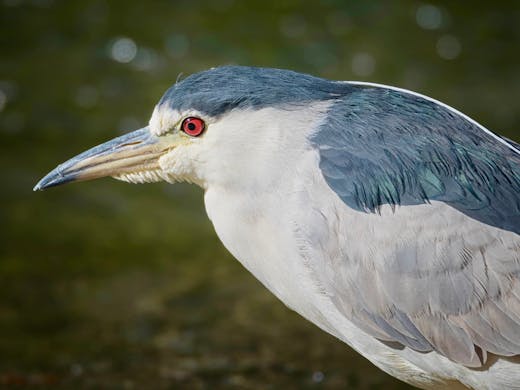Black-crowned Night Heron Nycticorax nycticorax
The Black-crowned Night Heron is a globally distributed species, with the exception of Australia and cold polar regions, and it thrives in freshwater or saltwater wetlands, boasting a carnivorous diet. This heron, known for its distinctive red eyes and comparatively shorter legs, is highly favored by birdwatchers and wildlife enthusiasts.
Specs
| Length | 64-76cm |
| Weight | 0.9-1.5kg |
| Wingspan | 97-122cm |
Common Names
| German | Nachtreiher |
| English | Black-crowned Night Heron |
| French | Bihoreau gris |
| Spanish | Martinete común |
Taxonomy
| Order | Pelecaniformes |
| Family | Ardeidae |
| Species | Nycticorax nycticorax |
Advertisement
We need your help! By making a contribution towards our hosting costs, you can help us provide an ad-free experience on our website in the near future. Paypal
How to Identify
I look for the black cap, white body and red eyes. Juvenile birds are brownish, darker where it will turn later to dark grey, and they already have the red eyes.
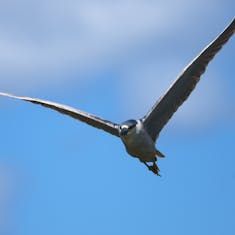
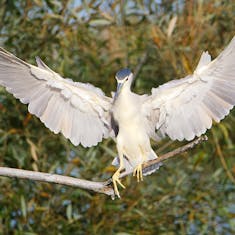
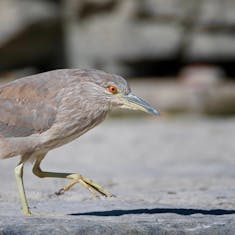
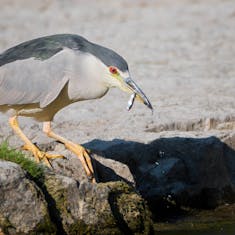
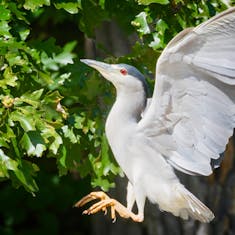

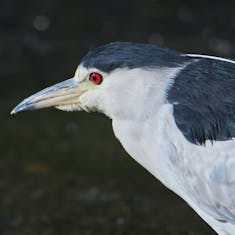
Black-crowned Night Heron Trivia
Are Black-crowned Night Herons popular among birdwatchers?
Yes, the Black-crowned Night Heron's distinctive appearance, including the striking red eyes, and their crepuscular behavior make them intriguing subjects for observation. Birdwatchers often seek opportunities to spot and observe these herons during their twilight hunting activities.
Is the Black-crowned Night Heron endemic to North America?
No, although the Black-crowned Night Heron is frequently found in North America, this species can also be found in South America, Europe, Asia, and Africa. An endemic species would be exclusive to a particular geographic location.
Is the Black-crowned Night Heron the smallest heron found in Canada?
No, both the elusive and shy Least Bittern and the Green Heron are smaller heron species than the Black-crowned Night Heron. The Black-crowned Night Heron is generally larger, typically standing at around 64 cm in height with a wingspan of approximately 102 cm.
Is the Black-crowned Night Heron a migratory bird?
Yes, while populations in the southern hemisphere often remain in the same area throughout the year, those in the northern hemisphere typically spend the summer in northern breeding areas and then migrate south in the fall to more suitable feeding grounds.
Do Black-crowned Night Herons have a short lifespan?
No, Black-crowned Night Herons do not have a particularly short lifespan. In the wild, they typically live for several years, with an average lifespan of around 10-15 years, despite facing numerous predators, including birds of prey. Additionally, terrestrial predators such as raccoons, foxes, and snakes pose a threat to their nests.
Do Black-crowned Night Herons prefer freshwater bodies?
Yes, Black-crowned Night Herons build their nests in reeds, bushes, or shrubs near rivers, ponds, and lakes. They often hunt along the shores of rivers and creeks and can thrive even in urban areas with suitable water sources.
Does the Black-crowned Night Heron have red eyes?
Yes, the eye color of this species is indeed a striking red, which can be observed even in juvenile individuals. The red eyes are a distinctive feature of this bird species, aiding in its identification. Other distinctive characteristics include the black crown feathers in adults, which give the bird its name.
Does the Black-crowned Night Herons have shorter legs than other herons?
Yes, although classified as a wading bird like other herons, the Black-crowned Night Heron doesn't possess the long legs typically associated with its relatives. This difference in leg length leads it to prefer perching on branches and rocks near water bodies when hunting for prey.
Is the Black-crowned Night Heron mainly active during the night?
No, this bird species isn't nocturnal. The Black-crowned Night Heron is active mostly during twilight hours and remains inactive during the day. This crepuscular behavior allows them to take advantage of low light conditions for hunting.
Are Black-crowned Night Herons carnivores?
Yes, the Black-crowned Night Heron primarily hunts for fish and other aquatic animals. However, this species is considered an opportunistic feeder and may occasionally consume terrestrial insects and small mammals as well.
Are Black-crowned Night Herons solitary hunters?
No, in contrast to many other heron species, Black-crowned Night Herons are often observed hunting in small groups, particularly during the breeding season. While they don't engage in cooperative hunting, this species is tolerant of the presence of other individuals nearby.
Is the Black-crowned Night Heron a bird of prey?
No, the Black-crowned Night Heron hunts for its prey, fishes and other aquatic animals, but this species is not classified as a bird of prey; it is considered a wading bird. Birds of prey include hawks, eagles, and owls.
Where and When to Spot
I first saw Black-crowned Night Herons in St. Eustache. Rapids Park Lachine is another place they can be seen frequently, either hidden within a tree close to the water where they like to fish. For photography, St. Eustache is better as they are getting very close.
| Spring | Summer | Fall | Winter | |
|---|---|---|---|---|
| Parc Angrignon | - | x | - | - |
| Parc de la Frayère | - | x | - | - |
| Parc des Rapides | - | x | - | - |
Where and when a species has been observed, identified, and recorded.
